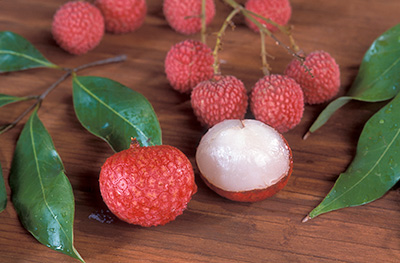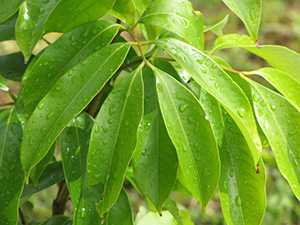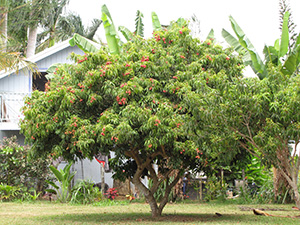Lychee
Lychee is a popular tree to grow in South Florida both as a specimen and a source of juicy, rose-flavored fruits.

Originally from southern China, lychee means “gift for a joyful life.” In addition to producing fruit, lychee also enchants the grower as an attractive specimen tree.
Characteristics
Lychee trees grow to be 30 to 50 feet tall and wide. The compact, rounded canopy reaches almost to the ground. The evergreen compound leaves are glossy and five to eight inches long. Tiny, pale white to yellow flowers emerge in the spring and are followed by fruit in the summer. Fruits range in color from pink to red, and have a unique bumpy, leathery skin. Lychee pulp is white and translucent (like a grape) and surrounds a single brown seed.
Lychee (Litchi chinensis) grows well in USDA Hardiness Zones 10A through 11. It is moderately tolerant of flooding and drought but cannot survive in salty environments. While no lychee cultivar is particularly consistent in fruit production, ‘Mauritius’ is the most popular cultivar since it tends to produce more fruit than others. Other recommended cultivars are ‘Brewster’, ‘Kwai May Pink’, ‘Emperor’, ‘Hak Ip’, and ‘Sweet Cliff’.
Bees and various fly species will pollinate lychee trees. Solitary trees still produce fruit, but recent studies suggest that planting more than one cultivar can increase fruit production.
Planting

Lychee works well as a feature in the yard, planted near a patio to provide shade, or in a shrub border. It also makes an ideal screen since the canopy is so dense. Lychees do not grow true from seed, so the easiest way to add them to your landscape is by purchasing container plants. You can also propagate lychees by air layering.
Choose a planting location that gets full sun and is at least 25 feet away from other trees, buildings and structures, and power lines. Ideally, the location should not be prone to major flooding during summer rainfall events. Lychee prefers well-drained soils, specifically acidic, sandy soil with moderate organic matter content.
Once you’ve picked a site, dig a hole that is three to four times the diameter and three times as deep as the tree’s container. This helps loosen the soil around the tree so roots can easily explore. If you are planting in an area with rockland soil, you can use a pick and digging bar to break up the rock, or hire a professional to use auguring equipment or a backhoe. If adding compost or topsoil is desired, mix it with the excavated soil in a ratio no more than 1:1.
Then, backfill the hole with enough of the removed soil to allow the soil in the tree’s container to be at or slightly above the surrounding soil area. Remove the tree from its container, place it in the hole, and add soil around the root ball. Once filled, immediately irrigate from the trunk to the edge of the roots. You can stake the tree, if desired, using cotton or natural fiber string that will degrade over time.
Maintenance

Applying a complete fertilizer on a consistent schedule will aid tree establishment. Micronutrients such as manganese, zinc, and iron should also be applied during the growing season (March to November). Once trees are fully mature (at least three years old), avoid any nitrogen-containing fertilizer in February and March. Nitrogen will encourage vegetative growth instead of the desired fruit production. See Table 3 in the Ask IFAS publication Lychee Growing in the Florida Home Landscape for the recommended fertilizer program.
Applying a thin layer of compost from the edge of the canopy to within six inches of the trunk can benefit the roots. Top the compost with a two- to six-inch layer of mulch to help retain soil moisture, prevent weeds from sprouting, and add organic matter to the soil. Use bark, wood chips, or something similar, but keep it 8-12 inches away from the trunk to prevent rotting.
Regular irrigation is necessary for establishing young trees. Once trees are bearing fruit, focus on regular irrigation from flowering through harvest. Mature trees will not require year-round irrigation.
The most severe pest of lychee is the Lychee Erinose mite (LEM). Although it is not lethal to mature trees, it can attack leaves, petioles, stems, panicles, flower buds, and fruit. An infestation can cause an 80% reduction in fruit production. The UF/IFAS Tropical Research and Education Center has provided in-depth instructions on identifying and controlling LEM (pdf).
Other potential insect pests include moths, scales, root weevils, and nematodes. Lychee is also susceptible to a few diseases, including anthracnose, mushroom root rot, parasitic lichen, and red algae. Mushroom root rot is more common if oaks were previously grown in the area. Contact your county Extension office for advice if pests or diseases become a problem.

Take care to maintain a grass-free area two to five feet away from the tree trunk. Keep lawn equipment away from the trunk because damage could kill the tree. Over-irrigation and over-fertilization of the surrounding lawn can also affect the tree because roots extend beyond the canopy. Excess water and fertilizer may reduce fruit quantity and/or fruit quality and cause root rot.
After three years or so, you’ll have fruits to harvest! They will ripen between May and July, with the highest production in June. Allow the fruits to ripen on the tree and then harvest them by cutting the main stem several inches above the fruit clusters. The fruits will store in the refrigerator for 5-10 days, but they are tastiest when eaten soon after harvesting.
Prune immediately after harvest so the tree has time to produce new growth before winter. Once the tree has been producing for several years, cut back the tops of the trees to 10-25 feet. Removing several top limbs annually helps protect the lower limbs from overshading and keeps the tree at a manageable size. Be sure to keep lower limbs intact because they are easiest to harvest fruit from and they provide valuable shade under the tree that prevents weeds.
For more information on growing lychees in your area, contact the experts at your county Extension office.
